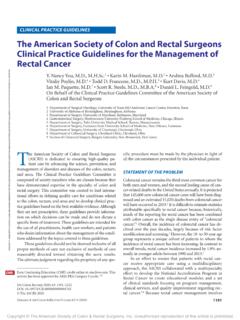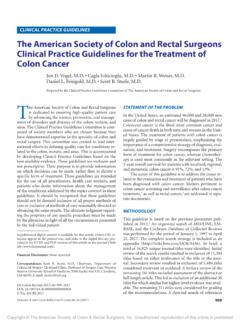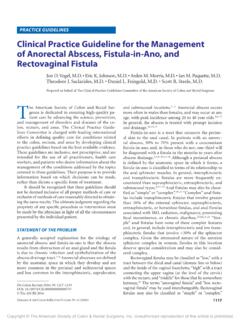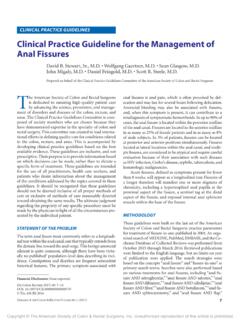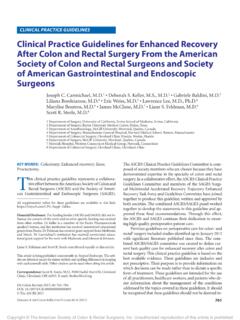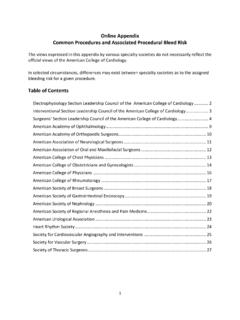Transcription of Antibiotic Prophylaxis Clinical Practice Guidelines ...
1 Antibiotic Prophylaxis Clinical Practice Guideline: Supporting Documentation Prepared by: The Standards Task Force The american society of Colon and Rectal surgeons Greg Oliver, , Project Director, Ann Lowry, , Committee Chair, Anthony Vernava, , Vice Chairman, Terry Hicks, , Council Representative, Marcus Burnstein, , Frederick Denstman, , Victor Fazio, , Bruce Kerner, , Richard Moore, , Walter Peters, , Theodore Ross, , Peter Senatore, , Clifford Simmang, , Steven Wexner, , W. Douglas Wong, It should be recognized that these Guidelines should not be deemed inclusive of all proper method of care or exclusive of methods of care reasonably directed to obtaining the same results.
2 The ultimate judgment regarding the propriety of any specific procedure must be made by the physician in light of all of the circumstances presented by the individual patient. Bacterial endocarditis is a serious, potentially fatal condition that may be associated with endoscopic procedures. Antibiotic Prophylaxis has been used to prevent endocarditis, but does involve risks. Endoscopists must assess the evidence and weigh the risks and benefits. Endocarditis Statement of the Problem Infective endocarditis is an infection of the endocardium, most commonly caused by a gram positive coccus, although gram negative bacillus and fungus can also produce the disease.
3 Before the introduction of antibiotics, endocarditis was, almost without exception, fatal. Modern medical and surgical treatments have altered the Clinical course of the disease, and a cure rate of 80 percent with a 50 percent ten year survival rate has been achieved.(1) Long term follow up of these "cured" cases reveals late morbidity in the form of heart failure or recurrent endocarditis that can require valve replacement, with a mortality rate of 5 to 10 percent.(2) Infective endocarditis comprises to 3 percent of all hospital admissions.
4 The statistical variation in the frequency is believed to be a result of inconsistencies in case definitions. The preponderance of endocarditis occurs in men (54 73 percent). The mean age has gradually increased from less than 39 years in 1943 to as old as 57 years.(3) In one study 55 percent of the patients were older than 60 years.(4) The majority of native valve endocarditis is caused by Streptococcus viridans (50 percent) and Staphylococcus aureus (20 percent).(5) In "early" prosthetic valve endocarditis Staphylococcus epidermis is the most frequent organism.
5 Late onset prosthetic valve endocarditis is similar to native valve endocarditis. Enterococcal endocarditis is usually associated with malignancy or manipulation of the genitourinary or gastrointestinal tract. Recently the HACEK group (Hemophilus, Actinobacillus, Cardiobacterium, Eikenella, and Kingella species) are becoming more important causes of endocarditis.(6,7) Do gastrointestinal endoscopic Procedures Cause Endocarditis? The rate of endocarditis depends on the incidence and intensity of bacteremia and the organisms causing bacteremia.
6 Bacteria vary in their capacity to colonize damaged heart valves. A review of endoscopic literature produced no evidence to implicate gastrointestinal procedures as a major precipitator of bacterial endocarditis. A survey of 123 endoscopy units in the United States revealed only four poorly documented cases of endocarditis, and a single, unconvincing case was found in the British medical literature.(8,9) It should be noted that most of the reviewed cases of endocarditis were reported after the advent of gastrointestinal endoscopy, but no evidence of an increase in the disease was offered.
7 (10,11) The phenomenon of transient bacteremia in human beings has been recognized for many years (Table 1). Hoffman and associates(12) detected bacteremia in 4 percent of their patients five minutes after rectal examination was performed. All isolates were anaerobic and contained in the normal fecal flora. As it related specifically to lower bowel endoscopy, the incidence of bacteremia ranges from 0 to 13 percent among patients undergoing rigid sigmoidoscopy.(13 16) LeFrock et al.(15) documented transient bacteremia in nearly 10 percent of their patients who underwent rigid sigmoidoscopy.
8 Eleven of 19 of the transient bacteremia cases associated with sigmoidoscopy involved enterococci. The rate of bacteremia reported for patients with rectal disease was similar to that for patients without disease. In some cases bacteremia was observed within the first minute of the procedure and lasted for as long as 15 minutes. Bacteremia was not detected after 30 minutes. Efforts to reproduce these data have been unsuccessful.(17) Table 1. Representative Rates of Bacteremia Procedure or Site Incidence (Range), % Tooth extraction 60 (18 85) Brushing teeth 40 (7 50) Upper endoscopy 4 (0 8) ERCP 3 (0 6) Barium enema 10 (5 11) Colonoscopy 5 (0 5) Flexible sigmoidoscopy 0 Rigid sigmoidoscopy 5 (0 13) ERCP = endoscopic retrograde cholangiopancreatography.
9 Adapted from Durack DT. Prevention of infective endocarditis, New England Journal of Medicine 1995;332:38 44.(11) Goldman et al.(18) reported a 1 percent incidence of transient bacteremia among 100 patients in whom flexible fiberoptic sigmoidoscopy was performed. Transient bacteremia rarely follows colonoscopy.(19 23) London et al.(24) reported a 4 percent incidence among 50 patients. There seems to be no correlation between biopsy or fulguration and bacteremia.(25) The 11 percent incidence of bacteremia after barium enema is similar to that associated with colonoscopy.
10 All of these bacteremias are asymptomatic. In addition, organisms present in the blood stream are usually not ones typically associated with endocarditis. Factors Associated with an Increased Risk of Endocarditis Although there are few reported cases of endocarditis after gastrointestinal procedures, it is appropriate to assess which patients are at increased risk and to determine whether certain bacteremias are more dangerous than others. Just how endocarditis develops from transient bacteremia is not understood.

